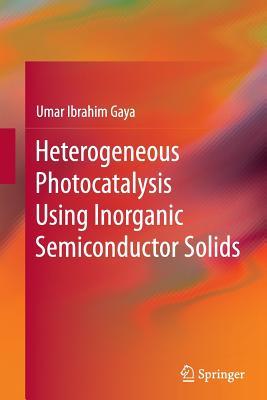Read Online Heterogeneous Photocatalysis Using Inorganic Semiconductor Solids - Umar Gaya file in PDF
Related searches:
Abstract photocatalytic heterogeneous organic transformation is considered as an efficient, clean atomic economy, and low-energy consumption strategy for organic synthesis.
These photocatalysts have superlinear increase of solar fuel production rate with light intensity, demonstrate highest selectivity, and higher efficiency of converting.
More than 907f all the chemical product formation processes are catalytic in nature and heterogeneous catalysis plays an enormous role.
The application of a new process for removal of emerging contaminants from wastewaters has become necessary. In this context, the heterogeneous photocatalysis can be considered more promising for the removal of this kind of pollutants.
Heterogeneous photocatalysts (hpcats) are an attractive alternative, as the requirement for the separation and purification is largely removed, but typically at the cost of efficiency. Flow chemical reactors can, to a large extent, mitigate the loss in efficiency through reactor designs that enhance mass transport and irradiation.
Heterogeneous photocatalysis utilizes photon energy and converts it into chemical energy, and offers great potential for many applications specially water and waste water treatment. This process is really effective in degrading a wide range of organic contaminants, eventually mineralizing them into carbon dioxide and water.
Kosera vs, cruz tm, chaves es, tiburtius erl (2017) triclosan degradation by heterogeneous photocatalysis using zno immobilized in biopolymer as catalyst.
Heterogeneous photocatalysis has evolved in a unique way giving rise to various applications for alternative energy, organic synthesis and environmental treatment.
Abstract and figures semiconductor heterogeneous photocatalysis, the subject of this review, is a versatile, low-cost and environmentally benign treatment technology for a host of pollutants.
Aug 8, 2019 this article discusses the future of heterogeneous catalyst materials and the role they play in modern energy and chemical industries.
Heterogeneous photocatalysis using inorganic semiconductor solids.
This promising technology can be achieved in a one-step excitation system using a single photocatalyst or via a z-scheme process based on a pair of photocatalysts. Ideally, such photocatalysis will proceed with charge separation and transport unaffected by recombination and trapping, and surface catalytic processes will not involve undesirable.
Photocatalytic oxidation of the sulfur-containing compounds, trimethylene sulfide (c3h6s), propylene sulfide (c3h6s), thiophene (c4h4s), and methyl disulfide (c2h6s2), was carried out using an annular plug flow reactor with tio2 in a supported form. Formation of products and byproducts was monitored in real time using a mass spectrometry online system.
Heterogeneous photocatalysis is one of the most studied aops that utilizes a light source to induce photochemical reactions on the surface of a semiconductor catalyst the tio 2 is one of the most commonly photocatalysts used due to its null toxicity, good chemical stability, and low cost.
Single-atom photocatalysts have shown their compelling potential and arguably become the most active research direction in photocatalysis due to their fascinating strengths in enhancing light-harvesting, charge transfer dynamics, and surface reactions of a photocatalytic system. While numerous comprehensions about the single-atom photocatalysts have recently been amassed, advanced.
The image symbolizes the activation of a heterogeneous photocatalyst by visible light and its application for organic synthesis.
Advanced oxidative processes such as the use of heterogeneous photocatalysis with tio 2, photolysis, peroxidation, photoperoxidation, fenton or photo-fenton reaction [12–16]. Heterogeneous photocatalysis is considered as a clean technology and use irradiation for the excitation.
Heterogeneous semiconductors, which are commonly used for artificial photosynthesis and wastewater treatment, are a sustainable alternative. Graphitic carbon nitrides, a class of metal‐free polymers that can be easily prepared from bulk chemicals, are heterogeneous semiconductors with high potential for photocatalytic organic transformations.

Post Your Comments: